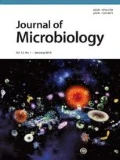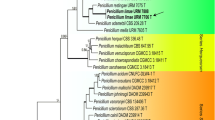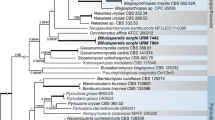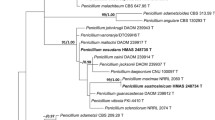Abstract
Two isolates of monoverticillate Penicillium species were collected from a grape and schisandra fruit in Korea. Multigene phylogenetic analyses with the nuclear ribosomal internal transcribed spacer (ITS) region and genes encoding β-tubulin (benA) and calmodulin (cmd), as well as morphological analyses revealed that the two isolates are members of the P. sclerotiorum complex in Penicillium subgenus Aspergilloides, but different from species of the P. sclerotiorum complex. The isolates are closely related to P. cainii, P. jacksonii, and P. viticola in terms of their multigene phylogeny, but their colony and conidiophore morphologies differ from those of closely related species. The name P. daejeonium is proposed for this unclassified new species belonging to the P. sclerotiorum complex in subgenus Aspergilloides.
Similar content being viewed by others
References
Agrios, G.N. 2005. Plant Pathology. 5th ed., pp. 553–557. Elsevier-Academic Press, Amsterdam-Boston, Netherlands-USA.
Cubero, O.F., Crespo, A.N.A., Fatehi, F., and Bridge, P.D. 1999. DNA extraction and PCR amplification method suitable for fresh, herbarium-stored, lichenized, and other fungi. Plant Syst. Evol. 216, 243–249.
Domsch, K.H., Gams, W., and Anderson, T.H. 1980. Compendium of soil fungi. Academic press, London, UK.
Fischer, G. and Dott, W. 2003. Relevance of airborne fungi and their secondary metabolites for environmental, occupational and indoor hygiene. Arch. Microbiol. 179, 75–82.
Frisvad, J.C. and Samson, R.A. 2004. Polyphasic taxonomy of Penicillium subgenus Penicillium. A guide to identification of food and air-borne terverticillate Penicillia and their mycotoxins. Stud. Mycol. 49, 1–173.
Glass, N.L. and Donaldson, G.C. 1995. Development of primer sets designed for use with the PCR to amplify conserved genes from filamentous ascomycetes. Appl. Environ. Microbiol. 61, 1323–1330.
Katoh, K., Asimenos, G., and Toh, H. 2009. Multiple alignment of DNA sequences with MAFFT. Methods Mol. Biol. 537, 39–64.
Nonaka, K., Masuma, R., Iwatsuki, M., Shiomi, K., and Otoguro, K. 2011. Penicillium viticola, a new species isolated from a grape in Japan. Mycoscience 52, 338–343.
Peterson, S.W. 2000. Phylogenetic analysis of Penicillium species based on ITS and LSU-rDNA nucleotide sequences, pp. 163–178, In Samson, R.A. and Pitt, J.I. (eds.). Integration of modern taxonomic methods for Penicillium and Aspergillus classification. Harwood Academic Publishers, Amsterdam, Netherlands.
Peterson, S.W. 2004. Multilocus DNA sequence analysis shows that Penicillium biourgeianum is a distinct species closely related to P. brevicompactum and P. olsonii. Mycol. Res. 108, 434–440.
Peterson, S.W., Bayer, E.M., and Wicklow, D.T. 2004. Penicillium thiersii, Penicillium angulare and Penicillium descaturense, new species isolated from wood-decay fungi in North America and their phylogenetic placement from multilocus DNA sequence analysis. Mycologia 96, 1280–1293.
Peterson, S.W., Pérez, J., Vega, F.E., and Infante, F. 2003. Penicillium brocae, a new species associated with the coffee borer in Chiapas. Mexico. Mycologia 95, 141–147.
Pitt, J.I. 1979. The genus Penicillium and its teleomorphic states Eupenicillium and Talaromyces. Academic Press Inc., London, UK.
Pitt, J.I. 2000. A laboratory guide to common Penicillium species. 3rd ed. Commonw. Scient. Industry Res., Organisation, North Ryde, Australia.
Pitt, J.I. and Hocking, A.D. 2009. Fungi and Food Spoilage 3rd ed., pp. 196–199. Springer Dordrecht, Heidelberg, London, UK.
Rivera, K.G., Diaz, J., Chavarria-Diaz, F., Garcia, M., Urb, M., Thorn, R.G., Louis-Seize, G., Janzen, D.H., and Seifert, K.A. 2012. Penicillium mallochii and P. guanacastense, two new species isolated from Costa Rican caterpillars. Mycotaxon 119, 315–328.
Rivera, K.G. and Seifert, K.A. 2011. A taxonomic and phylogenetic revision of the Penicillium sclerotiorum complex. Stud. Mycol. 70, 139–158.
Tamura, K., Peterson, D., Peterson, N., Stecher, G., Nei, M., and Kumar, S. 2011. MEGA5: Molecular evolutionary genetics analysis using maximum likelihood, evolutionary distance, and maximum parsimony methods. Mol. Biol. Evol. 28, 2731–2739.
Visagie, C.M., Houbraken, J., Rodriques, C., Silva Pereira, C., Dijksterhuis, J., Seifert, K.A., Jacobs, K., and Samson, R.A. 2013. Five new Penicillium speices in section Sclerotiora: a tribute to the Dutch Royal family. Persoonia 31, 42–62.
White, T.J., Bruns, T., Lee, S., and Taylor, J. 1990. Amplification and direct sequencing of fungal ribosomal RNA genes for phylogenetics. pp. 315–322. In Innis, M.A. et al. (eds), PCR protocols: a guide to methods and applications. Academic Press, San Diego, USA.
Author information
Authors and Affiliations
Corresponding authors
Rights and permissions
About this article
Cite this article
Sang, H., An, TJ., Kim, C.S. et al. Penicillium daejeonium sp. nov., a new species isolated from a grape and schisandra fruit in Korea. J Microbiol. 51, 536–539 (2013). https://doi.org/10.1007/s12275-013-3291-6
Received:
Accepted:
Published:
Issue Date:
DOI: https://doi.org/10.1007/s12275-013-3291-6




